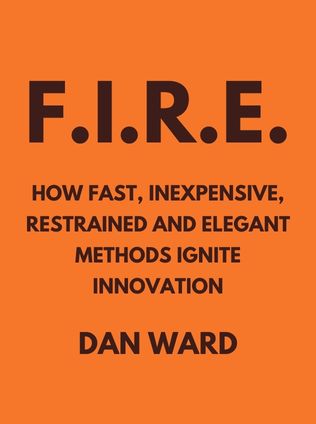
F.I.R.E.
How Fast, Inexpensive, Restrained and Elegant Methods Ignite Innovation
By Dan Ward
Published 04/2014
About the Author
Dan Ward is a principal consultant at Dan Ward Consulting, LLC, and a retired U.S. Air Force Lieutenant Colonel. With over 20 years of service, Ward's career spans extensive experience in researching, developing, and fielding military equipment. He holds three engineering degrees and has served in various prestigious assignments, including the Air Force Research Lab, the National Geospatial Intelligence Agency, the Pentagon, and International Security Assistance Force Headquarters in Kabul, Afghanistan. His contributions to military technology earned him the Bronze Star in 2012.
Main Idea
In "F.I.R.E.: How Fast, Inexpensive, Restrained, and Elegant Methods Ignite Innovation," Dan Ward explores why some projects deliver under budget and ahead of schedule while others exceed both time and cost estimates. He delves into how the world's top technologists consistently achieve best-in-class results with limited resources, using small teams and tight schedules. The F.I.R.E. method, although not infallible, provides strategic concepts, decision-making principles, and practical tools applicable to a wide range of projects, from military equipment to consumer electronics.
Table of Contents
- Introduction to F.I.R.E.
- Fast: Speed as a Strategic Advantage
- Inexpensive: The Power of Constraints
- Restrained: Less is More
- Elegant: Simplicity and Ingenuity
- F.I.R.E. Principles and Practices
- Case Studies: Successes and Failures
- Applying F.I.R.E. Beyond the Battlefield
- Conclusion: Embracing F.I.R.E.
Introduction to F.I.R.E.
The F.I.R.E. method, an evolution from the U.S. military's FIST (Fast, Inexpensive, Simple, Tiny), emphasizes using constraints to foster creativity. Developed over a decade and applied to various projects, F.I.R.E. extends these principles to civilian applications, aiming to produce effective, timely, and budget-friendly solutions. The method stands on four pillars: Fast, Inexpensive, Restrained, and Elegant, guiding project leaders to deliver superior products efficiently.
"In 2003, the acronym FIST (Fast, Inexpensive, Simple, Tiny) was coined to describe the U.S. military's approach to high-speed, low-cost innovation. This method uses constraints to foster creativity and, through a thoughtful application of speed, thrift, simplicity and restraint, has a track record of producing best-in-class and first-in-class technologies." – Dan Ward
Fast: Speed as a Strategic Advantage
The "F" in F.I.R.E. represents speed. Fast projects reduce exposure to change, enhance accountability, and align better with market needs and technologies. However, speed must not compromise quality. It's about defining realistic, short-term objectives and maintaining a rapid pace without cutting corners. Speed fosters stability, reduces risks, and ensures timely delivery of products.
"Speed enhances accountability and learning for the team members. Speed increases the likelihood that the product will be well aligned with both the market's interest and the available technologies." – Dan Ward
Successful projects often share a common trait: a sense of urgency that drives efficiency and focus. By setting tight deadlines, teams are compelled to prioritize critical tasks, streamline processes, and avoid unnecessary delays. This approach not only keeps projects on track but also fosters a culture of discipline and dedication.
For instance, in the development of the F-20 Tigershark, Northrop's designers emphasized affordability and speed, rolling out the first model in just 32 months. Although the project ultimately failed due to external factors, the rapid development timeline exemplified the power of speed in project execution.
Inexpensive: The Power of Constraints
The "I" stands for inexpensive. Working with a small budget drives innovation and efficiency. Contrary to popular belief, lower costs can lead to higher quality by encouraging creative problem-solving and resourcefulness. Inexpensive does not mean cheap; it means making smart, cost-effective decisions that optimize performance without unnecessary expenditure.
Sign up for FREE and get access to 1,400+ books summaries.
You May Also Like
The Life-Changing Magic of Tidying Up
The Japanese Art of Decluttering and Organizing
By Marie KondoThe Lean Startup
How Today's Entrepreneurs Use Continuous Innovation to Create Radically Successful Businesses
By Eric RiesWho Moved My Cheese?
An Amazing Way to Deal with Change in Your Work and in Your Life
By Spencer Johnson, M.D.Make Your Bed
Little Things That Can Change Your Life...And Maybe the World
By William H. McRaven



















